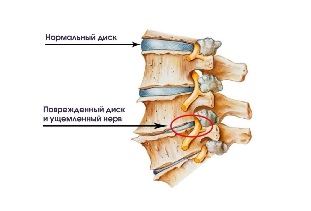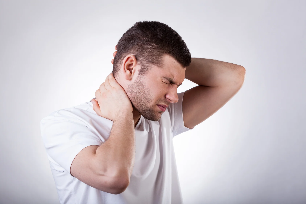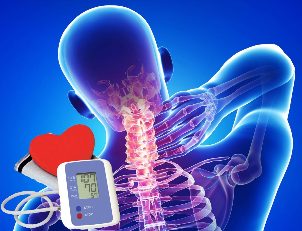The Cervical osteochondrosis and a certain dystrophic and the changes of clubs in the intervertebrals neck.

The negative impact that not only affects the discs themselves, but also the vertebrae, cartilage and soft tissue. The main feature of the cervical spine and the fact that their vertebrae do not have more reliable the structure in comparison with other departments, which makes this area very vulnerable. The vertebrae is located here very close to one and other arteries that carry the power of the human brain.
If there are un the displacement of the vertebrae, the possibility of fibres, compression nerve and the arteries, which inevitably go to the d hernia appearance an exit between vertebrae I, and said changes in the structure of the spine disc.
A What?
Osteochondrosis of the cervical spine (Osteohondroz) and degenerative diseases of the un-dystrophic lesions intervertebrals the of the clubs, that are themselves damaged discs, vertebrae and joints of the neck of the uterus, the decrease of the height of intervertebral discs. The disease progresses if you let me sense to try and may give rise to headaches, circulatory problems and even hernia. Like the osteoporosis, the disease occurs because of disorders of the metabolism mineral, causing the bones and joints become less strong.
Osteochondrosis can cause instability of the cervical spine (the symptoms and treatment are similar to the chondrosis, but have a number of features), which is often accompanied by displacement of the vertebrae. In turn, this accelerates the development of degenerative disc disease, spinal destruction Department.
Stage
The attending physician should determine the degree of development of cervical degenerative disc disease based on medical history and conducting the examination of the patient. To distinguish only four degrees:
- First degree. The disease in the Oxidized, the patient has s slight pain in the neck, which can be more intense if you start to a person turn their heads.
- Second degree. The patient may complain of intense pain in the cervical spine, which can be located in the upper part of the limbs. The clinical picture shows that at this stage of the development of the disease s observed un-pinched nerve fibers causing intense pain. Also, a highlight of the headache, weakness and General physical discomfort.
- Third degree. The pain becomes almost continuous, radiating to the shoulder or arm. Some patients diagnosed with the hernia of the intervertebrals the clubs, which leads to loss of sensation of the upper extremities. During the medical examination there is a noticeable decrease of the mobility of the neck of the uterus, and pain to palpation.
- Fourth grade. At this stage of the disease the intervertebral disc and almost completely destroyed. In its place, there is connective tissue, which leads to a deterioration of the un of the patient. He begins to feel pain, noise in the head and in the bad orientation in the space. Suggests that This, if we fixed the artery, which prevents the natural power of the brain.

The symptoms of degenerative disc disease of the cervical
Important symptoms of degenerative disc disease of the les are dizziness cervical, headaches blood pressure salts.
The diagnosis of the disease difficult, at times, the pain and not obvious, and the symptoms s deletes the character that, in addition, without proper control of the use of strong analgesics mask the signs of the disease. Patient unable to feel pain, sent a healthy, and this, if the fins that continues the development of irreversible processes in the tissues of the joints of the neck.
Headache in cervical osteochondrosis
This is one of the most frequent nonspecific signs of many diseases. Headaches are particularly common in the female population. And difficult to determine the cause of headaches, and, in addition, be associated with injuries of the spine. There are about 14 different reasons for headache in human beings.
The most common causes of headaches with the that is descriu pathology:
- Spasms of the vessels of the brain;
- The un pinched nerve roots;
- Reflection of the Un's increase in intracranial pressure.
Headache in cervical osteochondrosis can remember hypertension a sensation when, angina pectoris or stroke. Especially in the middle-aged and older, tend to have the risks of developing cops or heart attacks.
Feel the pain may be paroxysmal, constant, throbbing, and his partner.
When heart disease, the patients complain of discomfort in the chest, accompanied by a disturbance of the rhythm of the heart. To identify the cause only by a doctor qualified. In the case of headaches combined with nausea, dizziness and chest pain, made sure the ECG.

Dizziness Is with the cervical osteochondrosis
This condition does not always indicate degenerative disc clearly disease of the cervical spine.
Dizziness can be the result of:
- The inflammation in the middle or the inner ear;
- Spasms of the vessels of the brain;
- Violations transmission of nerve impulses;
- Problems with the apparatus vestibular com;
- Diseases of the cardiovascular system.
There are No clear criteria dizziness osteochondrosis. However, there are systemic and non-systemic dizziness, and they have different kinds of differences.
And advisable to know the differences between systemic and non-systemic dizziness, this will help us determine the causes of the unusual States:
- System vertigo of the sensation to move and the movement of the objects that surround us or the body to be a consequence of the interruption of the apparatus, such as vestibular, visual, receivers, analyzers and in the joints, muscles, and epidermis (low back pain of various etiologies);
- Non-systemic dizziness to a feeling of faintness, feeling dazed, not sure of the state in an upright position. When non-systemic dizziness, sensation of a circular rotation of a lack, a and I this difference with respect to the important of the language of signs.
The people who sent the vertigo of the type specified must be inspected by a doctor experienced, especially the un neurologist or (if there is a suspicion on disease of The ear and of the throat) of the un otolaryngologist.
The reason for the urgency of the need for hospitalization not related to degenerative disc disease of the cervical spine, and the identification of the patient (except vertigo) these signs such as:
- The Facial paralysis and the lack of sensitivity of the shoulder belt;
- Headache in the impairment of the health;
- Violation of coordination of movements;
- The loss or extinction of the consciousness.

The blood pressure with cervical osteochondrosis
The relationship of cervical degenerative disc irregular disease of the blood pressure has been established. The cervical vertebrae prominent are the nerve endings and the blood vessels.
Characteristic pressure changes during the day. Arterial hypertension for a long time not typical for this disease. Reflex irritation of the nerve endings and in the short-term spasms of the blood vessels cause un strong diurnal dynamics of arterial hypertension.
A distinctive feature of the Un and increase the pressure on the cervical osteochondrosis and a combination of the following symptoms:
- Headache;
- Pain in the limbs and the chest;
- The reduction of the sensitivity of the cervical area;
- The appearance of peaks of pressure stress work of original art, muscle tension, prolonged stay in an awkward position and other similar situations.
These characteristics have been taken into account in the self-differentiation of the hypertension of various Genesis.
The peaks of HELL and the rapid deterioration of the health are the base to seek medical assistance urgently.
Syndromes of osteochondrosis
The clinical picture of cervical degenerative disc disease fit in some syndromes. Syndrome this and symptoms multiple that are taken together.
Low back pain consists of the following syndromes:
- Spinal. Also called spinal and that indicates that are involved in the process of pathological bone and cartilage. This leads us to the formacio of these symptoms: restriction of motor activity of the neck, pain when it makes the un in the revolt, radiographic changes in the image of the cervical spine. That and the appearance simultaneously of these signs and a spinal syndrome. A similar set of signs observed myositis clinical ca (pathology of muscle tissue) painful and movement, the companion of many other diseases.
- Syndrome artery vertebral. When it Appears the involvement of the bundles veins, which are responsible for blood flow to the tissues of the Central nervous system. The symptoms suggests that the brain tissue has ceased to receive the proper amount of nutrients. Recognize How this syndrome? Primers are The signs dizziness, sensation of a noise in the ears, changes in blood pressure, the appearance of a "veil" in front of your eyes. This Suggests that one of the arteries, vertebral and stavlennia condition. Every boat has its own nerve endings. If you press the artery Innervate spinal will appear headache, numbness, transient loss of vision on one side. In the end, the vascular changes lead to the fact that the brain needs oxygen. At this time, the person is sent drowsiness, transient impairment of consciousness, loses focus and control, worse works and remembers information. With a picture has clinical to differentiate themselves from cervical degenerative disk of the with disease in the atherosclerosis arteries vertebral, and the compression by a tumor or inflammation.
- The cardiac function fetal. Seen burning in the chest,with dyspnoea. The man's apparent frequent of your palpitations, it becomes tired and irritable. This pattern, typical of the diseases of the heart, for example, angina, syndrome. coronary, heart attack. The conclusion exact about the causes symptoms of these can make the original picture the patient undergoes ECG.
- The syndrome. The neck of the womb innervates 8 pairs of piegaro, each of which takes place the nerve roots exit the spine. Their involvement in osteochondrosis, the patient has reduced the sensitivity to pain or Vice versa. You may experience numbness nape of if your pain, the reduction of the sensitivity of the tongue, behind the ear, pain in the area supraclavicular. Sometimes there are problems with swallowing, movements of the upper limbs, numbness of fingers and toes.
First aid in the home of the exacerbation during osteochondrosis
Serious When pain that you can use now analgesics such as Analgin, Tempalgin or Baralgin. If these drugs do not bring relief, you can take Aine (Nise or Diclofenac).
Often s uses "diversionary" means, for example, the Capsicum plaster that does not heal, but only heat the pain area me distracted from the pain. In the case of the formacio d edema in the area of inflammation, the patient may drink infusion diuretic or herbs for 3-4 days. A possible to cure osteochondrosis these methods? These measures are only temporary, reasons for treatment, you should contact your doctor.
It must be borne in mind, what doctor treats low back pain. If you suspect that the cause of pain in the cervical spine and the occurrence of low back pain, you should consult a neurologist. This technical se d in diseases of this type. Some medical institutions restricted specialists, dealing specifically with diseases of the spine. The clinic If you have a spine, you should ask a question how to cure this disease immediately to him.

How to treat the osteochondrosis cervical?
In the initial phase of development to cure the low back pain sense drug, n is enough to check the diet, the daily routine, regularly perform un set of special exercises of the. With advanced forms of the disease the treatment is only possible you and under the condition of application of various drugs that help to delay degenerative changes in the vertebrae.
In the set of therapeutic measures necessarily include physiotherapy – electrophoresis with drugs, ultrasound, magnetotherapy, laser therapy. These methods help to cope with the pain, inflammation and swelling of tissues, improves metabolic processes of the circulation and of the blood.
The medication
Principles of The methods of treatment of degenerative disc disease of the cervical spine and the medication, physical therapy, massage neck and neck area, especially with exercises effective therapeutic cervical osteochondrosis. The main groups of drugs used are in the disease:
| Name | The principle of operation |
| Anti-inflammatory drugs non-steroidal (Aine). And voltaren, Nise, Movalis, was Ketonal, Ketanov, diclofenac, nimesulide and other | Reduce the pain, reduce the inflammation and swelling of The spine of the damaged nerve. |
| Drugs that improve blood rheology and blood flow. This aminophylline, trental. | Improve the nutrition of the damaged nerve roots and improves blood flow to the brain. |
| Vitamins of the B group And combilipen, hungama, milgamma, neurobion. | Improve the processes in the metabolic and nervous tissue. |
| The muscle relaxants. This mydocalm, sirdalud, chiseled d', tizanidine, etc. | The drugs that Are relieve muscle spasm. |
| Chondroprotectors. It (and the glucosamine chondroitin) artra, teraflex, doppelgerts, toadstone, Andronova, structovis, alflutop. | And drugs that restore cartilage tissue, including damaged intervertebral disc. |
By taking a pill of degenerative disc disease, it should be remembered that a significant effect of drug pills treatment only if combined with other techniques, such as the of the year. It should also be noted that the attending physician should appoint for the treatment of the base about the disease, its stage, and other characteristics.












































